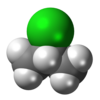2-chloropropane
|
|
|||
| Names | |||
|---|---|---|---|
|
IUPAC name
2-chloropropane
|
|||
| Other names
chlorodimethylmethane, isopropyl chloride, 2-propyl chloride, sec-propyl chloride
|
|||
| Identifiers | |||
|
3D model (Jmol)
|
|||
| ChemSpider | |||
| ECHA InfoCard | 100.000.781 | ||
|
PubChem CID
|
|||
| RTECS number | TX4410000 | ||
|
|||
|
|||
| Properties | |||
| C3H7Cl | |||
| Molar mass | 78.5413 | ||
| Appearance | Colourless liquid | ||
| Density | 0.862 | ||
| Melting point | −117.18 °C (−178.92 °F; 155.97 K) | ||
| Boiling point | 35.74 °C (96.33 °F; 308.89 K) | ||
| 0.334 g/100 ml at 12.5 °C | |||
| Solubility in ethanol | fully miscible | ||
| Solubility in diethyl ether | fully miscible | ||
|
Refractive index (nD)
|
1.3811 | ||
| Viscosity | 4.05 cP at 0 °C 3.589 cP at 20 °C |
||
| Hazards | |||
| Main hazards | Possible mutagen. May be harmful by ingestion, inhalation or through skin contact. | ||
| Safety data sheet | External MSDS | ||
| R-phrases | R11 R20 R21 R22 | ||
| S-phrases | S9 S29 | ||
| NFPA 704 | |||
| Flash point | −32 °C (−26 °F; 241 K) | ||
| Related compounds | |||
|
Related alkyl halides
|
Ethyl chloride n-propyl chloride Isopropyl bromide Isopropyl iodide |
||
|
Except where otherwise noted, data are given for materials in their standard state (at 25 °C [77 °F], 100 kPa).
|
|||
|
|
|||
| Infobox references | |||
Isopropyl chloride (also chlorodimethylmethane, 2-propyl chloride, sec-propyl chloride or 2-chloropropane) is a colorless, flammable chemical compound . It has the chemical formula C3H7Cl and is prepared by refluxing isopropyl alcohol with concentrated hydrochloric acid and zinc chloride.
Structurally, isopropyl chloride is an organochlorine compound as well as a secondary (2°) haloalkane, the latter designation identifying the two C-C bonds seen around the carbon atom covalently bonded with the chlorine substituent. To compare, its structural isomer, 1-chloropropane, is instead an example of a primary (1°) haloalkane, as the chlorine-bound carbon atom has only one C-C bond.
As a laboratory reactant, heating 2-chloropropane with alcoholic potassium hydroxide will yield propene (an alkene) by a dehydrohalogenation reaction. However, reacting with potassium hydroxide would compete with an SN2 nucleophilic substitution reaction (minor product) because OH−-ion is a strong, sterically unhindered nucleophile. Because of this, potassium tert-butoxide is one example of a better reagent to use.
...
Wikipedia



